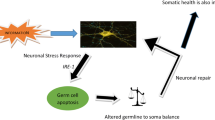Summary
The expression of many genetic defects may be suppressed by proper medical care or even by changing the environmental conditions. We have used the Penna model of ageing to show that such efFects may be responsible for increasing the human life expectancy during the 20th century. This effect is equivalent to the shift of the threshold (T) in the Penna model, which determines how many deleterious, expressed mutations kill an organism. For long genomes, the shift of T changes the age distribution significantly with negligible relative changes in the maximum life span, while for short genomes, the shift of T changes both, the age distribution as well as the maximum age. Unfortunately the same simulations show that the strategy of enhancing the medical care requires more and more effort to keep the mortality rate of our populations at the same lower level and that some new defects could be exposed to selection.
Similar content being viewed by others
References
Penna T. J. P. (1995) J. Stat. Phys., 78, 1629.
Bernardes A. T. (1996) Ann. Physik 5, 539; Moss de Oliveira S., de Oliveira P. M. C and Stauffer, D., Evolution, Money, War and Compters, Teubner, Stattgart-Leipzig 1999.
Stauffer D. (1996) Comput. in Phys. 10, 341.
Schneider J., Cebrat S., Stauffer D. (1998) Int. J. Mod. Phys. C 9, 721.
Penna T. J. P. and Stauffer D. (1996) Zeits. Phys. B 101, 469.
Pletcher, S., priv.comm. (Dec. 1999).
Mueller L. D. and Rose M. R. (1996) Proc. Natl. Acad. Sci. USA 93, 15249; Pletcher S. D. and Curtsinger J. W. (1998) Evolution 52, 454.
De Oliveira P. M. C., Moss de Oliveira S., Stauffer D. and Cebrat S. (1999), Physica A, 273, 145.
Wachter, K. W. and Finch, C. E. (1997) Between Zeus and the Salmon. The Biodemography of Longevity, National Academy Press, Washington, D. C.; Thatcher A. R., Kannisto K. and Vaupel J. W., The Force of Mortality at Ages 80 to 120, Odense University Press, Odense 1998; Azbel M. (1999), Proc. Natl. Acad. Sci. USA 96, 3303.
Malarz, K. (2000) Int. J. Mod. Phys. C 11, No. 2.
Copp A. J. (1995) Trends Genet. 11, 87.
Cebrat, S. and Pekalski, A. (1999) Eur. Phys. J. B 11, 687.
Author information
Authors and Affiliations
Rights and permissions
About this article
Cite this article
Niewczas, E., Cebrat, S. & Stauffer, D. The influence of the medical care on the human life expectancy in 20th century and the Penna ageing model. Theory Biosci. 119, 122–131 (2000). https://doi.org/10.1007/s12064-000-0008-2
Received:
Accepted:
Issue Date:
DOI: https://doi.org/10.1007/s12064-000-0008-2




